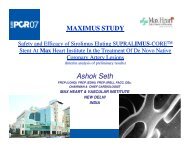Covalently Conjugation of Genistein with Biodegradable Poly L ...
Covalently Conjugation of Genistein with Biodegradable Poly L ...
Covalently Conjugation of Genistein with Biodegradable Poly L ...
You also want an ePaper? Increase the reach of your titles
YUMPU automatically turns print PDFs into web optimized ePapers that Google loves.
146 P. Sojitra, A. Raval, D. Kothwala, A. Rawal, H. Kotadia, S. Adesharapeanuts [8] and in dietary is<strong>of</strong>lavones such asbeans and legumes [9]. Phenolic rings in<strong>Genistein</strong> is are responsible for estrogenreceptor binding [10]. The hydroxyl group at theC-4’ position enhanced the antioxidantproperties <strong>of</strong> <strong>Genistein</strong> drug. The structure <strong>of</strong><strong>Genistein</strong> consisting <strong>of</strong> two benzyl rings by athree- carbon bridge, which is simplified as C 6-C 3-C 6. It is also classified as a phytoestrogensdue to its weak estrogenic activity in mammaliansystems [11].<strong>Genistein</strong> is a potential flavonoid whichpossesses anti-thrombotic and antiproliferativeproperties. Data suggest that<strong>Genistein</strong> may exert a strong anti-carcinogeniceffect, and that this effect possibly involves aninduction <strong>of</strong> p21, which inhibits the thresholdkinase activities <strong>of</strong> Cdks and associated cyclins,leading to a G2/M arrest in the cell cycleprogression [12, 13]. It inhibited collage inducedhuman platelet aggregation in a dosedependentmanner [14,15]. It has been shownto enhance NO production from theendothelium. NO is a potent inhibitor <strong>of</strong> plateletadhesion, aggregation and thrombosis.Impaired platelet production <strong>of</strong> NO has beenassociated <strong>with</strong> acute coronary syndromes.Thus <strong>Genistein</strong> may affect platelet aggregationvia an NO-dependant signal transductionpathway, a potential mechanisam. Theantitumor effect <strong>of</strong> <strong>Genistein</strong> has been reportedthrough the inhibition <strong>of</strong> protein kinasepathways leading to gene expressionmodification <strong>of</strong> many proteins, including VEGF.Novel drug-biodegradable polymer conjugatescan serve the purpose <strong>of</strong> sustained drugdelivery simultaneously <strong>with</strong> the polymerdegradation period. In the present study,<strong>Genistein</strong> was conjugated <strong>with</strong> biodegradablePLLA and was performed as coating on coronarystent.Materials and methodsThe Stainless steel 316L electropolished stents(16mm length) were used in the present study.L-Lactide (Boehringer-Ingelheim, Germany)was purified by recrystallization from dry ethylacetate and dried in vacuo at room temperature.<strong>Genistein</strong> was obtained from Ren YoungPharmaceutical Co Ltd, China and used <strong>with</strong>outfurther purification process. Stannous octoate(Sn-oct, Sigma), Dicyclohexylcarbodiimide(DCC, FLUCA), 4-(dimethyl amino) pyridine(DMAP, FALUCA), dichloromethane (DCM),Dimethyl Sulphoxide (DMSO) and otherchemicals used in the current investigationwere <strong>of</strong> HPLC grade procured from RanbaxyFine Chemicals Ltd, India.MethodsPLLA was synthesized by the reported method[16]. Briefly, L-lactide (10 g, 0.07 mol) wasmelted at 180 °C for 30min in a nitrogenatmosphere. Stannous octoate (0.1 wt % <strong>of</strong> L-lactide) was added to the melted L-lactidesolution. The mixture was degassed and stirredat 150 °C for 30 min. The product was dissolvedin chlor<strong>of</strong>orm and then precipitated in excessmethanol. The precipitate was filtered and driedovernight under vacuum.A DCC, DMAP chemistry was used to synthesizethe PLLA-<strong>Genistein</strong>. <strong>Genistein</strong> C 15H 10O 5(0.02702 gm 1x10 -4 mol) and PLLA (0.1g,2.0x10 -4 mol) was dissolved in the DMSO (50ml), N, N-dimethyl formamide (DMF, 50 ml)respectively. DCC (2x10 -4 mol) and DMAP (2x10 -4mol) were added to drop by drop PLLA solutionin DCM was added to <strong>Genistein</strong> solution <strong>with</strong>stirring for 10 min at constant 50°C. The reactionwas further carried out for 18 hours undernitrogen atmosphere. After the couplingreaction, the reaction solution was precipitatedin excess methanol. The precipitate wasdissolved in chlor<strong>of</strong>orm and the solution wasprecipitated in excess methanol. After filtering,the precipitate was dried at 35°C for 24 h invacuum to eliminate the residual solvent.HPLC analysis <strong>of</strong> <strong>Genistein</strong> were performed onHPLC-LC-2010 AHT [Shimadzu (Asia Pacific)Pvt. Ltd.] consisting <strong>of</strong> X-Terra RP-18 (250*4.6mm) analytical column having particle size 5µm.The drug content was analyzed using mobilephase consisting <strong>of</strong> acetonitrile: methanol:water (45:35:20 v/v) at flow rate <strong>of</strong> 1.2 ml/minand oven temperature 40°C. The retention timefor <strong>Genistein</strong> was kept at 2.9 minute and wasdetected at 254 nm by UV absorption.This analysis was performed on mother liquorto set molar ratio <strong>of</strong> genistein and PLLA. Liquorwas taken from the reaction mixture at each 18




